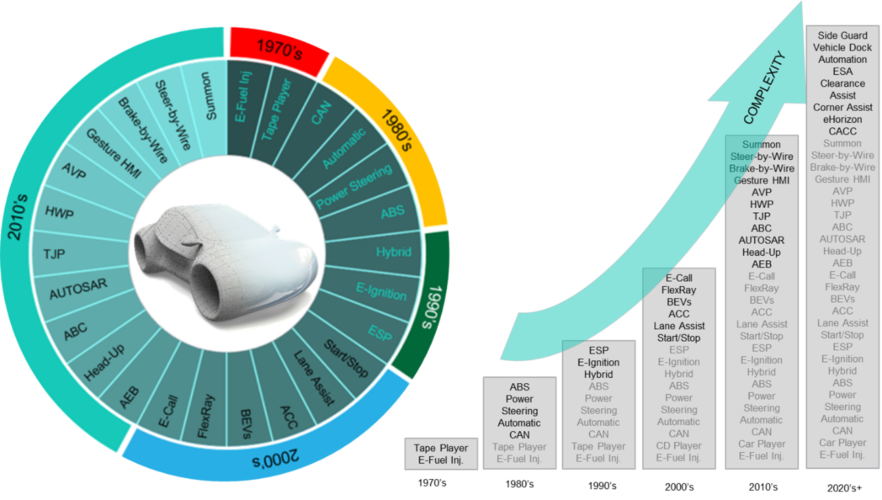As vehicles become ever more complex, Ricardo has been applying model-based systems engineering to help OEMs develop better connected and automated products in the automotive, off-highway and construction market sectors.

Systems engineering is an interdisciplinary and systematic approach to successfully realising a product by focusing on customer needs early in the development cycle. In the 1970s and 1980s vehicles were comparatively simple with predominantly mechanical standalone systems. Today products are extremely complex, containing a large number of interacting systems mostly containing electronics and software. As new systems are added the complexity compounds and becomes a major challenge for OEMs All of the features need to interact, be safe and reliable and deliver the attributes that vehicle manufacturers want.

The impact of changes in mobility of people and goods, and in particular the impact of autonomy and increased connectivity is putting pressure on vehicle constructors by increasing vehicle complexity and driving up development cost and risk. There are many potential benefits and drivers for connectivity and automation (Figure 2), although the value of each potential application needs to be examined carefully to understand whether a business case exists considering the potential complexity of implementation.
CLICK HERE FOR MORE SUSTAINABLE MOBILITY CONTENT
Autonomy and connectivity are accelerating the increase in feature explosion illustrated in Figure 1. There are many new systems, sensors and actuators, and new architectures are required to support advanced safety concepts. When we include connectivity in the product we need to consider the product as part of a larger ecosystem so that the product is not just a standalone vehicle, it has to interact with other parts of the system.
Many of the near term automated road vehicles are somewhat limited in connectivity. We are, however, already seeing increased connectivity in off-highway and construction applications and more connectivity will come to road vehicles through greater vehicle to vehicle and ‘vehicle 2 everything’ connectivity as well as through developments in intelligent transportation systems.

There are many potential benefits available through a model-based systems engineering approach (Figure 3). Systems engineering enables a product to achieve its potential, reducing risk and development cost. More and more OEMs are interested in systems engineering as a way to develop well engineered products early on and to avoid the huge costs associated with resolving issues – particularly around safety - once a vehicle has been released into the market. Another key benefit of systems engineering is that it promotes reuse so that product designs are not discarded and can be reapplied through future products.

Ricardo employs a feature driven model-based systems engineering approach (Figure 4), that brings together a feature driven focus on the customer needs with a V-model development model. We focus on the left hand side of the V where the feature driven development approach allows the vehicle complexity to be managed efficiently. The approach integrates physical and functional modelling tools and techniques; requirements management and modelling are a key part. The approach includes consideration of the feature performance as well as functional safety, digital resilience and safety of the intended function (SOTIF). Ricardo’s systems engineering experts act as a bridge between customer stakeholders and the technical implementation of the development teams, ensuring that needs are translated into component designs with minimal defects.

Figure 5 shows the feature driven process in more detail. The process starts with understanding the problem, applying domain expertise to capture and refine OEM inputs into a feature definition which can then be played back to the OEM. Features are refined into feature streams and the function, functional scenarios and use cases are modelled. Consolidation and bounding involves grouping similar functions together and reducing the amount of overlap. In the design step Ricardo develops the intended functional concepts including the safety concept, the security concept and the performance concept. In the refine step Ricardo makes a joined-up view of how the product will operate and work out an agreement and trade-offs between the concepts.

For many different OEMs Ricardo has employed this approach which includes advanced platooning automation, automated mobility services, confined area automation, as well as off-highway and construction automation. Figure 6 shows an example for construction where an OEM was interested in features to protect site workers while the machine was driving as well as while being operated, and also for safe navigation in a confined site.
Ricardo defines the system behaviour and analyses the use cases and scenarios using systems modelling language (SysML), then defines the system performance and constraints. A functional architecture is defined and the functional safety, security and SOTIF concepts derived. Sensors and actuators are then identified based on the expected technology performance and availability, before deriving a physical architecture. From there Ricardo refines the scenarios and models them in simulation together with the construction environment and move to designing and developing the control algorithms.
Using a feature driven model-based systems engineering approach enabled us to determine in simulation the sensor positions and locations for the various use cases and to access the impact of the various vehicle characteristics. The approach allowed for a high level of reusability and scalability of control algorithms and sensor configurations across the OEM’s construction product range for both vehicle movement and construction equipment operation. The impact of changes to vehicle, environment or use cases could be easily analysed and simulated as well as evaluating trade offs in architectures.
Vehicle complexity is set to increase, especially with new mobility concepts for people and goods and advances in connectivity and automation. Employing a model-based systems engineering approach is key to managing this complexity and to delivering high quality products on time and within budget.
To find out how Ricardo expertise is powering sustainable mobility, visit: https://automotive.ricardo.com/ or contact us: info@ricardo.com





Nanogenerator consumes CO2 to generate electricity
Nice to see my my views being backed up by no less a figure than Sabine Hossenfelder https://youtu.be/QoJzs4fA4fo